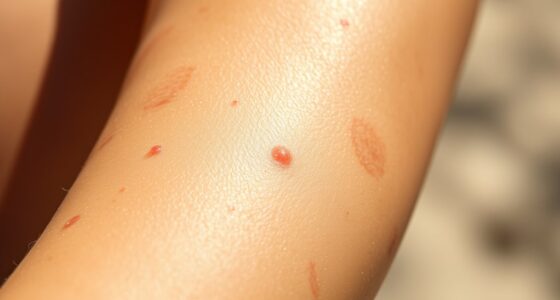Exfoliating before tanning is essential because it removes dead skin cells that can cause uneven patches and dull results. By creating a smooth surface, exfoliation helps your tan go on more evenly and last longer. It also improves color vibrancy and prevents streaks or blotches. Properly prepared skin absorbs tanning products better, giving you a flawless glow. Keep going to discover how to choose the right method and avoid common mistakes for the best results.
Key Takeaways
- Exfoliation creates a smooth surface, preventing rough patches and uneven color during tanning.
- It enhances product adherence, resulting in a more uniform, vibrant, and longer-lasting tan.
- Removing dead skin cells improves tan penetration and reduces streaks and blotchiness.
- Exfoliating before tanning supports skin renewal and maintains healthy, luminous skin.
- Proper exfoliation helps extend the durability and evenness of your tan over time.
The Role of Exfoliation in Skin Preparation
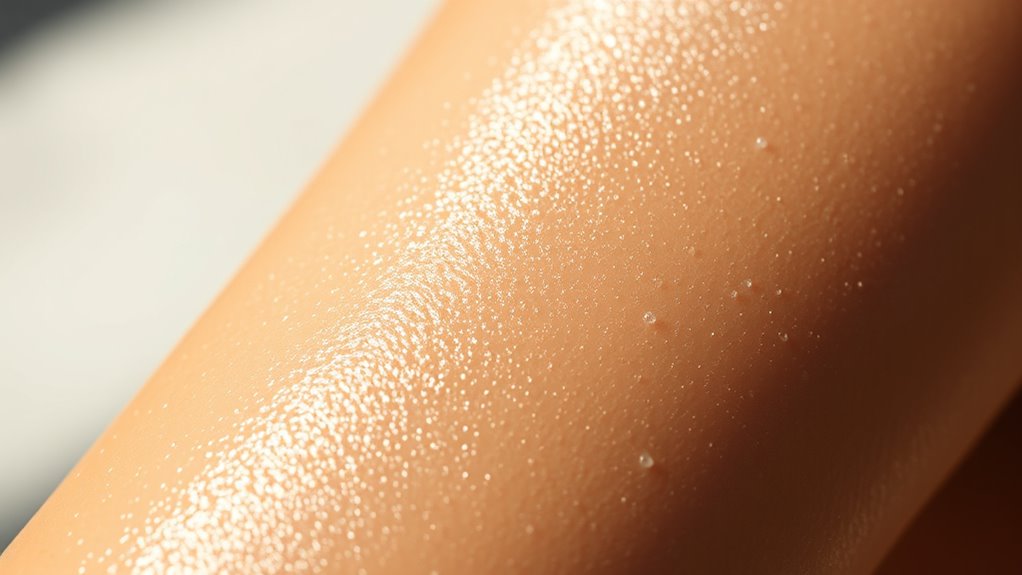
Exfoliation plays a crucial role in preparing your skin for tanning by creating a smooth, even surface. It removes dead skin cells that cause rough patches, ensuring the tanning product applies evenly without streaks or patchiness. A smoother skin surface also helps the tanning solution adhere better, resulting in a more uniform color. Regular exfoliation maintains an even skin texture, preventing uneven color development during your tanning sessions. It unclogs pores, allowing tanning products to penetrate more effectively, which enhances the richness and vibrancy of your tan. Plus, exfoliating removes dry, flaky skin that could cause premature fading, helping your tan last longer. Proper skin preparation with exfoliation sets a flawless foundation for achieving a natural, even, and long-lasting tan. Additionally, understanding skin types can help you choose the most suitable exfoliation method for optimal results. Incorporating nutritional factors such as vitamins A, C, and K can also support healthier skin, improving your overall tanning outcome.
How Dead Skin Buildup Affects Tanning Results
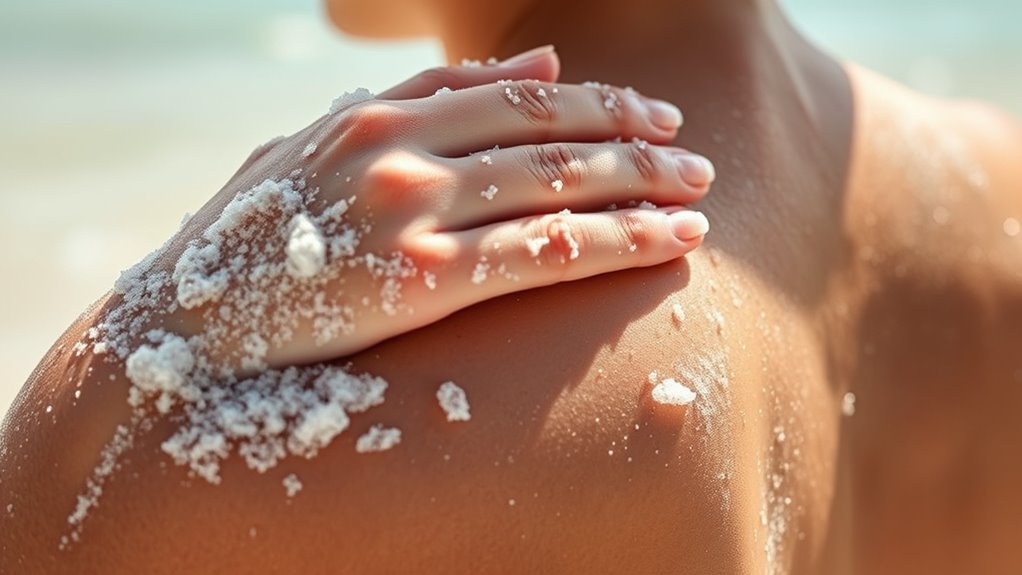
Dead skin buildup directly impacts how evenly your tan develops, often leading to patchy or uneven results. Dead skin cells can block tanning products from penetrating evenly, causing spots that are lighter or darker than desired. This buildup also dulls your skin’s appearance, making your tan look less vibrant. When dead skin isn’t removed, it can interfere with how well tanning products absorb, reducing their effectiveness. As a result, your tan may fade faster or look inconsistent across different areas. Additionally, excess dead skin can create a rough texture, causing uneven application and less smooth results. Regular exfoliation helps remove these dead cells, promoting a more uniform and long-lasting tan. Proper exfoliation also enhances skin smoothness, making the application of tanning products more effective. Overall, dead skin buildup hampers the tanning process, making regular exfoliation essential for achieving a flawless, long-lasting tan. Incorporating exfoliation techniques into your skincare routine can significantly improve your tanning results and skin health.
Benefits of Exfoliation for Even Tan Application
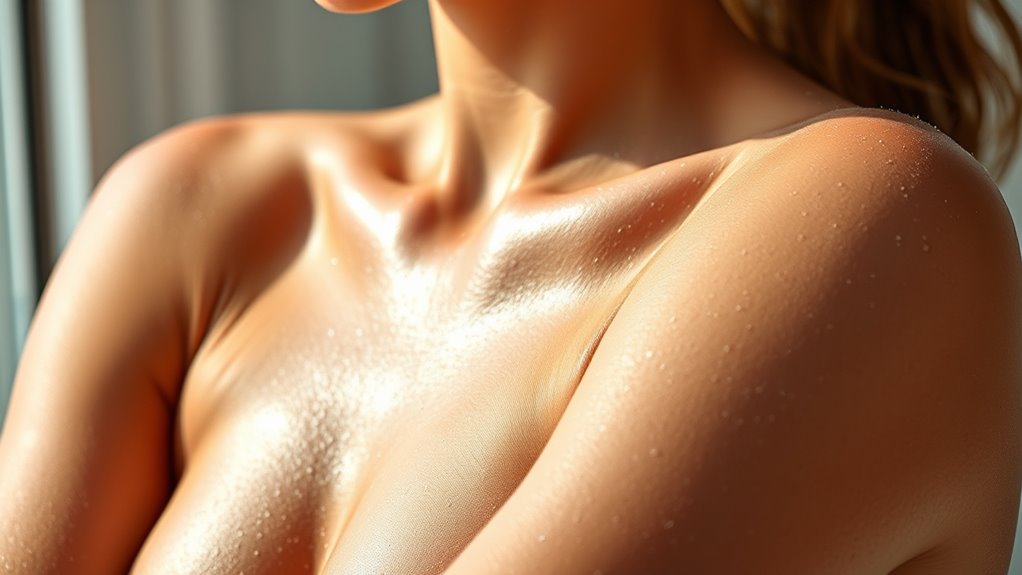
Achieving an even tan depends heavily on preparing your skin properly. Exfoliation removes dead skin cells, creating a smooth surface that helps tanning solutions adhere evenly. It also prevents patchiness and uneven results by eliminating rough, flaky areas. When you exfoliate, your skin absorbs tanning products better, leading to a more vibrant, consistent glow. Plus, it brightens your complexion, making your tan look more radiant. Proper exfoliation is a vital step before tanning because it guarantees your skin is receptive and ready for an even application. Focus on key areas like elbows and knees, and use gentle exfoliants suited to your skin type. Regular exfoliation maintains healthy skin, ultimately producing a smoother, more natural-looking tan with fewer streaks or blotches. Additionally, understanding your skin’s personality traits can help you choose the most suitable exfoliation methods for your skin type, ensuring optimal results. Incorporating skin preparation techniques into your routine can further enhance your tanning outcomes and promote healthy skin for a flawless tan.
Extending the Longevity of Your Tan

Understanding how your skin renews itself is key to making your tan last longer. Your skin’s renewal cycle takes about 28 days, during which dead cells are shed and replaced. Regular exfoliation helps accelerate this process by removing dead skin, allowing new cells to take hold and maintain the tan. When you exfoliate, you improve product absorption and promote even distribution of color, preventing patchiness and uneven fading. Additionally, smoother, exfoliated skin better retains moisture, which helps prolong your tan’s vibrancy. Using the right headphones during your skincare routine can help you enjoy relaxing moments while caring for your skin. By exfoliating once or twice a week, especially a day or two before tanning, you support healthy skin turnover and create an ideal base. This routine enhances the longevity of your tan, ensuring it stays fresh and even for longer periods. Incorporating skincare routines that include exfoliation can also help maintain overall skin health and prevent dryness. Engaging in proper skin care practices not only boosts your tan’s appearance but also promotes healthier skin over time. Incorporating ingredients that support nutritional benefits of chia seeds, such as antioxidants and essential minerals, can further promote skin health and radiance.
Preparing Skin for Sun and Spray Tanning

Preparing your skin correctly before sun or spray tanning guarantees a flawless, even result. Start by exfoliating at least 12 hours prior to tanning to remove dead skin cells, dirt, and oils that can cause uneven absorption. Focus on rough areas like elbows, knees, and ankles for better color distribution. Mechanical scrubs or chemical exfoliants (like AHAs) help create a smooth surface, allowing the tanning products or UV rays to develop evenly. Avoid heavy moisturizers immediately after exfoliating, as they can block absorption. Clean, exfoliated skin promotes better adherence of tanning solutions, reducing streaks and patchiness. Incorporating vetted indoor gardening tools can help maintain healthy, exfoliated skin by supporting overall skin health and hydration. Using proper skin preparation techniques ensures your tan develops evenly and lasts longer. Ensuring your skin is well-hydrated after exfoliation also enhances the application process and prolongs the longevity of your tan. Additionally, leveraging advancements in machine learning technology can help personalize skincare routines, optimizing exfoliation and hydration strategies tailored to individual skin types. Regularly evaluating your skin’s response with skin analysis tools can further refine your preparation routine for optimal tanning results.
Skin Health and Cosmetic Advantages of Exfoliating

Exfoliating your skin offers more than just a smooth surface; it provides significant cosmetic and health benefits. By removing dead skin cells and excess oils, you open clogged pores, reducing the risk of acne and breakouts. Regular exfoliation helps keep your skin clearer and healthier over time. It also enhances your skin’s radiance by revealing brighter, fresher skin underneath and boosting collagen production, which minimizes fine lines and wrinkles. Exfoliation stimulates blood flow, increasing oxygen and nutrients to your skin, supporting renewal and reducing puffiness. It smooths rough patches, evens out skin tone, and diminishes hyperpigmentation, making your skin look more refined. Plus, it improves the effectiveness of skincare products by allowing better absorption, maximizing their benefits for a healthier, more vibrant complexion. Incorporating exfoliation into your skincare routine can also prepare your skin better for tanning, ensuring a more even and long-lasting tan. Additionally, skin renewal processes are accelerated, helping to maintain youthful skin as you age. Regular exfoliation can also prevent clogged pores, which is essential for maintaining a clear complexion over time. Incorporating exfoliation into your routine can also stimulate circulation, which enhances overall skin health and appearance.
Choosing the Right Exfoliation Method for Your Skin

Choosing the right exfoliation method depends on your skin type and its specific needs. If you have sensitive skin, opt for gentle, natural scrubs like oatmeal that minimize irritation. Oily skin benefits from oil-absorbing options such as sugar scrubs or oil-free products to control excess shine. For dry skin, avoid harsh scrubs and choose moisturizing exfoliants with oils or humectants to prevent further dryness. Normal skin can handle both physical and mild chemical exfoliants, offering flexibility. Combination skin requires targeted approaches—using oil-absorbing scrubs on oily areas and moisturizing products on dry patches. Consider product ingredients carefully—look for natural options with minimal chemicals. Avoid harsh or synthetic ingredients to prevent redness and sensitivity, ensuring your skin is smooth and balanced before tanning. Recognizing the diverse beach experiences available across various destinations can help you plan a relaxing or adventurous getaway to complement your skincare routine. Additionally, selecting an exfoliation method that suits your skin sensitivity can enhance your overall tanning results and skin health. Staying informed about AI in Education and technological advancements can also inspire innovative skincare approaches and personalized treatments.
Best Practices for Exfoliating Before Tanning

To get the most even and long-lasting tan, timing your exfoliation is key. Exfoliate ideally 12-24 hours before tanning to give your skin time to recover and reduce sensitivity. Avoid exfoliating too close to your session, as open pores can lead to uneven spots like “strawberry legs.” A hot, steamy shower beforehand helps open pores and softens skin, making dead skin removal more effective. Plan your exfoliation at least a day prior to your tanning appointment to ensure maximum absorption. Use circular motions during exfoliation to maximize dead skin removal and stimulate circulation. Focus on rough areas like feet, elbows, and knees, but avoid harsh scrubbing to prevent irritation. Regular exfoliation 1-2 times weekly helps maintain smooth skin and prolongs your tan.
Common Mistakes to Avoid When Exfoliating

Are you aware of the common mistakes that can sabotage your exfoliation efforts before tanning? Exfoliating too close to your tanning session can prevent the solution from adhering evenly, so avoid doing it right before tanning. Also, don’t skip waiting at least 24 hours after exfoliating; rushing this step can lead to uneven color and open pores. Never exfoliate immediately after tanning, as this can strip away your tan and reduce its longevity. Using harsh chemicals or aggressive scrubbing can irritate your skin and cause patchiness. Be sure to choose gentle exfoliants suited to your skin type and avoid over-exfoliating sensitive areas. finally, neglecting to moisturize afterward can leave your skin dry, making your tan look uneven and patchy.
Tips for Maintaining Smooth, Tanned Skin
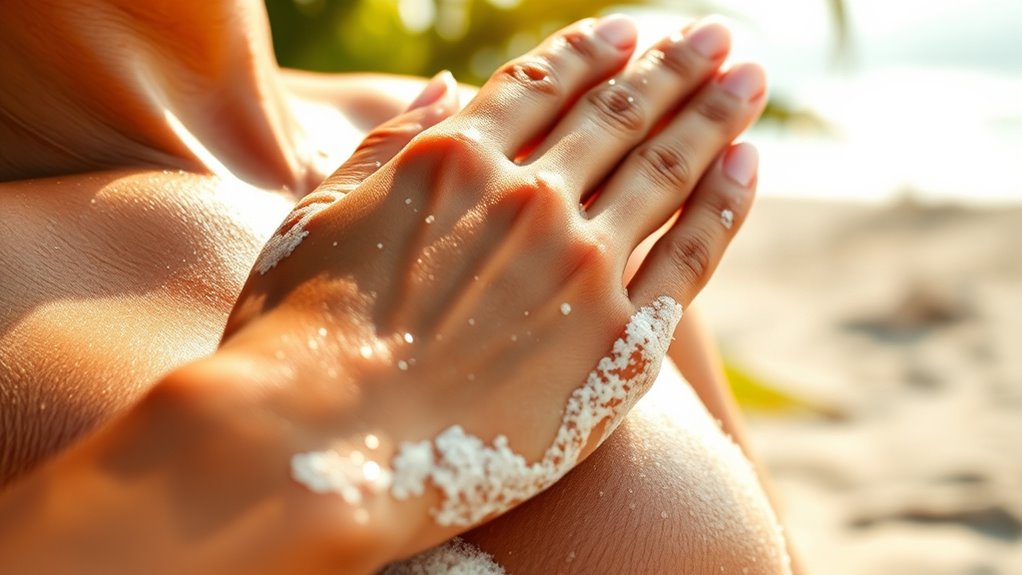
Proper exfoliation helps create a smooth base for tanning, but maintaining that smoothness afterward is key to a long-lasting, radiant glow. To do this, keep your skin well-hydrated by moisturizing twice daily with oils and butters like shea, jojoba, or apricot kernel oil. Hydrated skin retains color longer, develops more evenly, and feels velvety. Avoid hot showers and harsh cleansers that strip moisture, and pat your skin dry gently to prevent peeling. Incorporate foods rich in beta-carotene and antioxidants to support skin health from within. Wear light-colored clothing to showcase your tan and use sunscreen to prevent uneven fading. Ultimately, limit exfoliation after tanning, and use nourishing body oils to keep your skin soft, smooth, and radiant.
Frequently Asked Questions
How Often Should I Exfoliate Before Tanning for Best Results?
You should exfoliate once or twice a week to prepare your skin for tanning. For best results, do a thorough exfoliation 12 to 24 hours before your session, focusing on rough areas like elbows and knees. Avoid over-exfoliating right before tanning to prevent irritation. Regular exfoliation keeps your skin smooth and promotes even, longer-lasting tans, ensuring you get a natural-looking, flawless finish every time.
Can Exfoliating Too Much Damage My Skin Before Tanning?
Yes, exfoliating too much can damage your skin before tanning. Overdoing it strips away natural oils and disrupts your skin barrier, leading to redness, dryness, and increased sensitivity. This makes your skin more prone to irritation and breakouts, which can negatively impact your tan. To avoid this, limit exfoliation to once or twice a week, and always moisturize afterward to keep your skin healthy and protected.
What Types of Exfoliants Are Safest for Sensitive Skin?
You want to know which exfoliants are safest for sensitive skin. Gentle options like those with low concentrations of alpha hydroxy acids (AHAs) such as mandelic or lactic acid work well. Polyhydroxy acids (PHAs), like gluconolactate, are even milder. Look for products with calming ingredients like oat bran extract, coconut milk, or hyaluronic acid. These help exfoliate without irritating, keeping your skin balanced and ready for tanning.
Should I Exfoliate Differently for Spray Tanning Versus Sun Tanning?
You should exfoliate differently for spray tanning and sun tanning. For spray tanning, exfoliate at least 12 hours beforehand with gentle scrubs or chemical exfoliants to create a smooth, clean surface. Avoid oils or moisturizers right before. For sun tanning, exfoliate weekly with mild, hydrating products to remove dead skin and promote an even, long-lasting tan. Focus on high-friction areas like elbows and knees for both methods to prevent uneven patches.
How Do I Know if My Skin Is Properly Exfoliated for Tanning?
You’ll know your skin is properly exfoliated when it feels smooth and looks brighter, with an even tone. Your pores should appear minimized, and dead skin buildup reduced. If your skin absorbs tanning products well and there are no patches or rough areas, that’s a good sign. Consistent exfoliation helps prevent uneven results, so stick to a routine that leaves your skin soft, radiant, and ready for a flawless tan.
Conclusion
So, next time you plan to tan, don’t skip the exfoliation. Imagine your skin as a blank canvas, smooth and ready for that perfect glow. When you prep properly, your tan will look flawless and last longer. But neglecting this step could leave you with uneven patches or fading spots. Are you ready to access that radiant, even tan? The secret lies in the right prep—are you prepared to make it happen?



